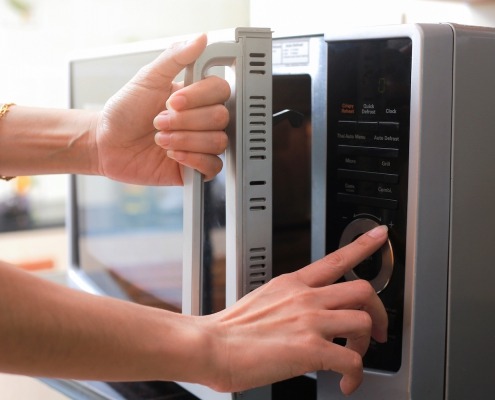Microwave Not Heating? Here’s How to Test the Thermal Fuse
Steven E / Monday May 12, 2025
Have you ever tried heating leftovers in your microwave oven only to find it completely dead? No fans, no turntable rotation, just cold silence. Chances are your microwave’s thermal fuse has blown causing everything to shut down. But how can you tell if this tiny safety component has failed or tripped without taking the unit apart?
With some basic preparation and safety awareness, we can determine if a replacement is needed. We’ll also get familiar with what thermal fuses do and why they commonly fail in the first place. If you need any replacement parts for your microwave, you can enter your model number at AppliancePartsPros.com to order them. Most orders arrive in just two business days, and we have thousands of free videos to show you how to install your new parts. Let’s get started.
The information in this article may not apply to your specific appliance model. We recommend consulting your manufacturer’s documentation or contact us with any questions.
What is a thermal fuse and what does it do?
So what exactly is a thermal fuse? First, a fuse in general is a protective device designed to fail and interrupt dangerous excessive amounts of electrical current flow. This opens the circuit path and cuts power to prevent wires, components, or insulation within appliances from overheating or even catching fire.
A thermal fuse does essentially the same job but more specifically reacts and blows from excessive heat rather than just current alone. It contains a special low melting point alloy that breaks the electrical connection if temperatures get dangerously high, around 250-300°F. This tells you something got too hot inside the cabinet which could melt wires or start burning plastic insulation.
Microwaves work by generating super high temperatures inside to quickly cook your food using intense dielectric heating. However, things can go wrong, like when the cooling fan gets jammed or there’s an electrical short, causing components like the magnetron tube to overheat. That’s where the thermal fuse comes in as a cheap backup protection, saving your microwave from serious meltdowns. Just remember, once it blows, you’ll need to replace it to get your microwave up and running again.
Safety first
Your safety should always be the top priority when performing any appliance repair. Please be very careful while working on a microwave since it contains high-voltage parts:
- Always unplug the microwave and discharge the high-voltage capacitor before working on it to eliminate the risk of electric shock.
- With the microwave unplugged, remove the outer case to gain internal access.
- Never power on the microwave without the cover in place.
- Wear insulating gloves and use insulated tools when testing any parts.
- Check all parts for damage before reassembling and powering up the microwave again.
Discharging a microwave capacitor
IMPORTANT: Carefully follow the correct handling and discharge procedures since exposure to the voltage levels inside a microwave can potentially cause severe injury or death. Prioritize safety at all times and follow the instructions and recommendations provided by the manufacturer. If you do not feel comfortable discharging a capacitor, do not attempt to do it yourself.
- Unplug the microwave from the power source.
- Grab a screwdriver with good insulation on the handle to protect against electric shock.
- Gently touch the insulated screwdriver blade to one terminal of the capacitor.
- Slowly and gently slide the screwdriver forward until it reaches the other terminal of the capacitor. Hold it there for a few seconds. This discharge process often produces a loud and startling ‘POP’ sound.
- Repeat the process to create a short circuit between each capacitor terminal and the chassis (bare metal mounting plate surface). If the capacitor has three terminals, use the same method.
How to diagnose a blown thermal fuse
When you first discover your microwave dead with no signs of life, how can you confirm it was the little thermal fuse that caused the catastrophe? Since the tiny fuse is hidden away on hot internal parts, you can’t just peek inside to check it visually. A blown fuse can appear identical to one still intact.
Here’s a safe, easy way to test and diagnose a potentially tripped thermal fuse using some basic tools and methods:
Continuity check
The only way to conclude if your thermal fuse has failed is by checking it for continuity. Continuity refers to an unbroken and continuous electrical pathway through a component or circuit. If the pathway through the fuse has opened up, you’ll know it blew doing its job to protect the microwave.
With the microwave safely unplugged, we can check continuity across the fuse easily using a simple tool called a multimeter. This handy electrical debugging gadget can measure important things like voltage, current, and resistance. We’ll use the resistance setting to check if our fuse wiring stops current flow like an open circuit (no continuity) versus allowing it like a closed circuit (full continuity).
Set your multimeter to the lowest resistance range, usually 200 ohms for standard analog meters, potentially lower for fancy digital ones. On some models, a special continuity beeper mode can be used instead which simply sounds an audible tone when the probes are connected through low resistance.
Zero your meter first before checking by touching the red and black probes together. On analog this nulls the needle, for digital you want to hear the solid continuity tone. This makes sure you have accurate readings.
Then with the microwave unplugged and the fuse removed/accessible, touch probes to the terminals or wires on each end of the thermal fuse. If meter resistance drops to 0 ohms or continues beeping, that confirms continuity through the fuse meaning it did NOT blow.
But if resistance stays high or the tone cuts out, the fuse has opened, lost continuity, and will need replacement.
Remember:
0 Ohms = Continuous Path = Good Fuse
High Ohms = Open Path = Blown Fuse
While you’re probing, also inspect for any visibly burnt wires or components nearby that could have caused fuse failure.
More information
A blown fuse often hints at deeper electrical issues within. Once replaced, monitor carefully on restarting. If it fails again, you may have other failures.
Thanks for stopping by! We hope this guide helped you test your microwave thermal fuse.
If you run into any issues, just give us a call at 1-877-477-7278 or start a chat with a pro on our website so we can help you through it. We’ve got many more troubleshooting and repair guides on our DIY blog and YouTube channel, and, of course, all the parts you need to do it yourself at AppliancePartsPros.com.
Make sure to connect with us on Facebook, Twitter and Instagram!
With nearly a decade of experience in providing top-notch customer service regarding appliance parts and repair, Steven enjoys sharing practical advice, troubleshooting tips, and interesting information to help readers stay informed.





